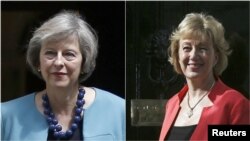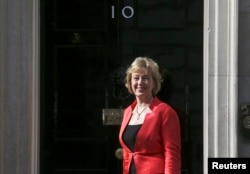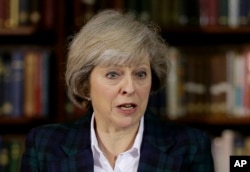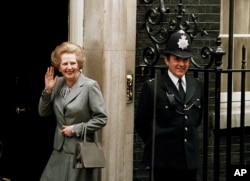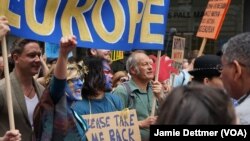Britain appears to be heading to having a woman prime minister again — 26 years since the country’s first, Margaret Thatcher, left office after a Conservative Party coup largely mounted over the country’s membership in the European Union.
The leading candidates to replace David Cameron as leader of the ruling Conservatives and the country’s prime minister are now both women — the country’s tough-minded Interior Minister Theresa May, and Energy Minister Andrea Leadsom, a less experienced politician.
The three male contenders in the race appear to be losing ground fast among Conservative lawmakers, who vote in a series of secret ballots starting Tuesday to whittle the field until two candidates are left. The party’s 150,000 grass-roots members make the final decision in a postal ballot scheduled to be held by September 2.
Leadsom, who campaigned for Brexit in the referendum, is attracting endorsements from MPs who’d planned to back former London Mayor Boris Johnson before his withdrawal from the race in a bitter fallout with fellow Leave campaigner Michael Gove.
Women in leadership
She told the Daily Telegraph in an interview Saturday: “I am a big fan of seeing more women in public life. Women have a huge amount to offer.”
Coincidentally, Labour, too, could end up being led by a woman — Anna Eagle, who may announce Monday a leadership challenge to leftist Jeremy Corbyn. Women rule also extends to Scotland with female First Minister Nicola Sturgeon, and a Conservative Party leader north of the border also a woman.
An increasing number of Tory MPs are saying privately that only a woman can sort out the mess Britain is in now following the unexpected referendum result that has set the country upside down. It is a view “Iron Lady” Thatcher would no doubt have endorsed vigorously.
She had no time for feminism, saying once, “I owe nothing to women’s lib.” But she was a firm believer that women are far more practical than men.
According to her biographer Charles Moore, “She had quite a low opinion of the male sex. Men are lazy and vain, she thought,” he wrote recently. “And one thing she believed in was the female ability to take a real-life rather than an official view of what the country and its citizens needed,” he added.
Commentators and Tory lawmakers are already drawing parallels between Thatcher and May, in particular. Like Thatcher, May, 59, is seen as unclubbable and aloof.
'Get on with the job in front of me'
May touched on this herself in a speech last week when she launched her leadership bid, saying: “I don’t gossip about people over lunch. I don’t go drinking in Parliament’s bars. I don’t often wear my heart on my sleeve. I just get on with the job in front of me.” She also — unlike most British lawmakers — avoids socializing with political journalists.
Some describe her as an Ice Queen, but like Thatcher — also a woman not good at small talk — she is said by colleagues to be warm and generous-minded in private. Also like Thatcher, she maintains a ferocious work schedule, focusing on detail and working through government papers until 2 or 3 in the morning.
A former top policeman, Peter Fahy, who clashed with her over police reform, told The Times: “She’s politically astute, totally professional and very good on detail, which might come in useful when it comes to negotiating with Europe.”
May is now garnering support not just from Tory lawmakers who backed the Remain camp in the Brexit referendum, but also from some who want to leave the EU but who see her as the best “unity candidate” as well as the contender best equipped to handle what will be fraught and prolonged negotiations with the EU.
Some senior Conservative MPs are now trying to persuade May’s rivals to withdraw, arguing that deciding on a new leader sooner rather than later and without a vote by lawmakers would benefit the party. They worry a drawn-out competition could become divisive and want to contrast Tory unity with the ugly divisions rending the opposition Labour Party.
But many Brexit-backing lawmakers doubt May’s readiness to implement a full break with the EU. She has already reversed herself on pulling Britain out of the European Convention on Human Rights, saying there is not enough political support in the country at large to do so.
Human rights bugbear
The Human Rights Convention has long been a bugbear of Tories, who dislike the involvement of the European Court of Human Rights in British legal and political affairs.
And there are signs that May as prime minister might agree to modified freedom of movement in return for a trade deal with the EU. All the remaining 27 EU member states are insisting any trade deal would have to include the right of EU citizens to live and work in Britain, with Britons accorded the same opportunity in EU states.
Brexit lawmakers insist there should be no freedom of movement, arguing the British public wants a massive reduction in immigration. But in her speech launching her leadership campaign last week, May’s wording on what deals she would and would not agree to with the EU was careful.
On the free movement of people, she said there could be no deal “as it has worked hitherto.”
“Those five words give her plenty of wiggle room,” says a government official.
March for Europe
Meanwhile, police estimated that 30,000 pro-EU protesters marched through Central London Saturday to demand that Britain not break with Europe.
The protest was organized by grass-roots activists via Facebook and attracted a variety of speakers, including rock star Bob Geldof and Michael Cashman, a former British soap opera star who served many years in the European Parliament.
Now a working peer in Britain’s House of Lords, he told VOA: “The government has got to go to the country with another option. I think there must be a second referendum with several different options."
He added: “This is bigger than us. It will impact generations to come. When the decision is so huge, you need to pause for thought, and they have not done that. Across party lines I have never seen the House of Lords so somber. People are saying this is the biggest crisis we have ever faced in peacetime.”
In Photos: March for Europe




